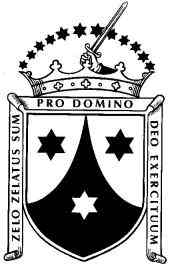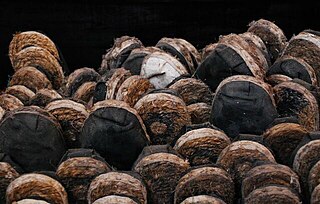
The Order of the Brothers of the Blessed Virgin Mary of Mount Carmel, known as the Carmelites or sometimes by synecdoche known simply as Carmel, is a Roman Catholic mendicant religious order for men and women. Historical records about its origin remain uncertain, but it was probably founded in the 12th century on Mount Carmel in the Crusader States. Berthold of Calabria, as well as Albert of Vercelli, have traditionally been associated with the founding of the order, but few clear records of early Carmelite history have survived. The order of Carmelite nuns was formalised in 1452.

Isaac or Sahak of Armenia (354–439) was Catholicos of the Armenian Apostolic Church. He is sometimes known as "Isaac the Great," and as "Sahak the Parthian" owing to his fathers Parthian origin, while his mother was an Armenian princess of the Mamikonian family.

The Scapular of Our Lady of Mount Carmel belongs to the habit of both the Carmelite Order and the Discalced Carmelite Order, both of which have Our Lady of Mount Carmel as their patroness. In its small form, it is widely popular within the Latin Church of the Catholic Church as a religious article and has probably served as the prototype of all the other devotional scapulars. The liturgical feast day of Our Lady of Mount Carmel, July 16, is popularly associated with the devotion of the Scapular.

Albert of Jerusalem, also Albertus Hierosolymitanus, Albertus Vercelensis, Saint Albert, Albert of Vercelli or Alberto Avogadro, was a canon lawyer and saint. He was Bishop of Bobbio and Bishop of Vercelli, and served as mediator and diplomat under Pope Clement III. Innocent III appointed him Patriarch of Jerusalem in 1204 or 1205. In Jerusalem, he contributed the Carmelite Rule of St. Albert to the newly-founded Carmelite Order. He is honoured as a saint in the Roman Catholic Church and commemorated by the Carmelites on 17 September.
The Litany of the Saints is a formal prayer of the Roman Catholic Church as well as the Old Catholic Church, Anglo-Catholic communities, and Western Rite Orthodox communities. It is a prayer to the Triune God, which also includes invocations for the intercession of the Blessed Virgin Mary, the Angels and all the martyrs and saints upon whom Christianity was founded, and those recognised as saints through the subsequent history of the church. Following the invocation of the saints, the Litany concludes with a series of supplications to God to hear the prayers of the worshippers. It is most prominently sung during the Easter Vigil, All Saints' Day, and in the liturgy for conferring Holy Orders, the Consecration of a Virgin and reception of the perpetual vows of a religious or a diocesane hermit.

Basilian monks are Greek Catholic monks who follow the rule of Basil the Great, bishop of Caesarea (330–379). The term 'Basilian' is typically used only in the Catholic Church to distinguish Greek Catholic monks from other forms of monastic life in the Catholic Church. In the Eastern Orthodox Church, as all monks follow the Rule of Saint Basil, they do not distinguish themselves as 'Basilian'.

The term third order signifies, in general, lay members of Christian religious orders, who do not necessarily live in a religious community such as a monastery or a nunnery, and yet can claim to wear the religious habit and participate in the good works of a great order. Roman Catholicism, Lutheranism and Anglicanism all recognize third orders.

Simon Stock, OCarm was an English Catholic priest and saint who lived in the 13th century and was an early prior of the Carmelite order. The Blessed Virgin Mary is traditionally said to have appeared to him and given him the Carmelite habit, the Brown Scapular. Thus, popular devotion to Stock is usually associated with devotion to Our Lady of Mount Carmel.

The Discalced Carmelites, known officially as the Order of the Discalced Brothers of the Blessed Virgin Mary of Mount Carmel or the Order of Discalced Carmelites, is a Catholic mendicant order with roots in the eremitic tradition of the Desert Fathers. The order was established in the 16th century, pursuant to the reform of the Carmelite Order by two Spanish saints, Teresa of Ávila (foundress) and John of the Cross (co-founder). Discalced is derived from Latin, meaning "without shoes".
Anastasius I of Antioch was the Patriarch of Antioch twice.
A Catholic order liturgical rite is a variant of a Catholic liturgical rite distinct from the typical ones, such as the Roman Rite, but instead specific to a certain Catholic religious order.

The Rite of the Holy Sepulchre, commonly called the Carmelite Rite, is the liturgical rite that was used by the Canons Regular of the Holy Sepulchre, Hospitallers, Templars, Carmelites and the other orders founded within the Latin Patriarchate of Jerusalem.

A discalced congregation is a religious congregation that goes barefoot or wears sandals. These congregations are often distinguished on this account from other branches of the same order. The custom of going unshod was introduced into the West by St Francis of Assisi for men and by St Clare of Assisi for women.

Saint Simeon Stylites the Younger, also known as Simeon of the Admirable Mountain, is a saint in the Catholic Church and Eastern Orthodox Church.

The Carmelite Monks or Monks of the Most Blessed Virgin Mary of Mount Carmel are a public association within the Diocese of Cheyenne, dedicated to a humble life of prayer. The Wyoming Carmelites claim loyalty to the Magisterium of the Catholic Church and to the Carmelite charism. Their life includes strict separation from the world and the living of the cloistered Carmelite spirituality and way of life established by John of the Cross and Teresa of Jesus. In accord with the Carmelite Rule, they engage in manual labor and the study of Carmelite spirituality in the solitude of the mountains, with the firm hope of attaining to Union with God.
The eremitic Rule of Saint Albert is the shortest of the rules of consecrated life in existence of the Catholic spiritual tradition, and is composed almost exclusively of scriptural precepts. To this day it is a rich source of inspiration for the lives of many Catholics throughout the world.
Telesphorus of Cosenza was a name assumed by one of the pseudo-prophets during the time of the Western Schism. As an pseudonymous author of a Latin work Liber de magnis tribulationibus, the name was attached to a 1365 production of the Fraticelli. The Liber was updated to fit the situation in the Schism.
Confessor of the Faith is a title given by some Christian denominations. In Catholicism and Eastern Orthodoxy, Christians who professed their faith in times of Christian persecution and therefore had to suffer persecution, expulsion, torture, mutilation and imprisonment, but not directly undergo martyrdom, are called confessors. Later, popes, bishops, abbots, kings and hermits were also counted among the confessors.
Genesius, Count of Clermont was a noble of Gaul and reputed miracle worker. He was said to be Count of Auvergne. His residence was at Combronde.

Joannicius the Great was a Byzantine Christian saint, sage, theologian and prophet. Well known for his devoted asceticism and defense of icon veneration, Joannicius spent the majority of his life as a hermit on Mysian Olympus, near what is today Bursa, Turkey. Joannicius lived during the reign of Emperor Theophilos, a noted iconoclast, which contrasted with Joannicius's embrace of icon veneration. Icon veneration was later restored to the Byzantine Empire under the reign of Empress Theodora, a move that some devotees ascribe to Joannicius's influence and prophecies. Joannicius served in the Byzantine army in his early years before devoting his life to ascetic study and monastic contemplation. He is venerated with a feast day on November 4 in the Eastern Orthodox Church and Roman Catholic Church.












